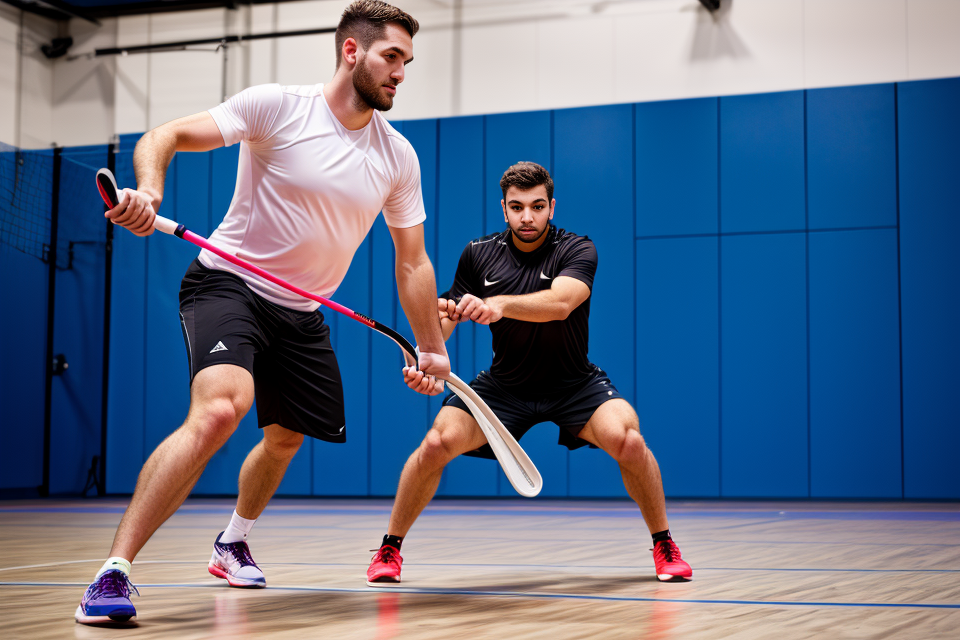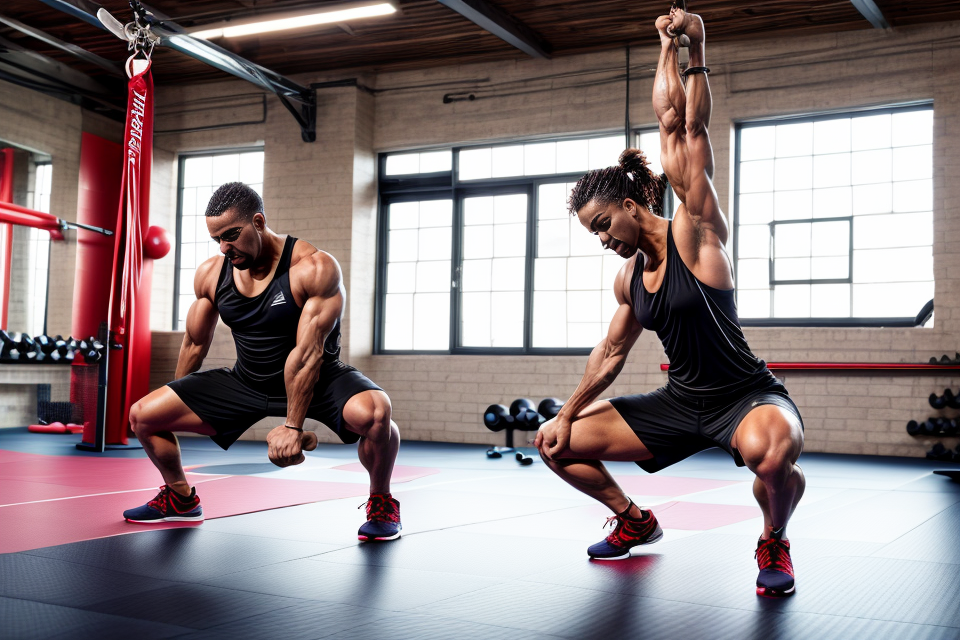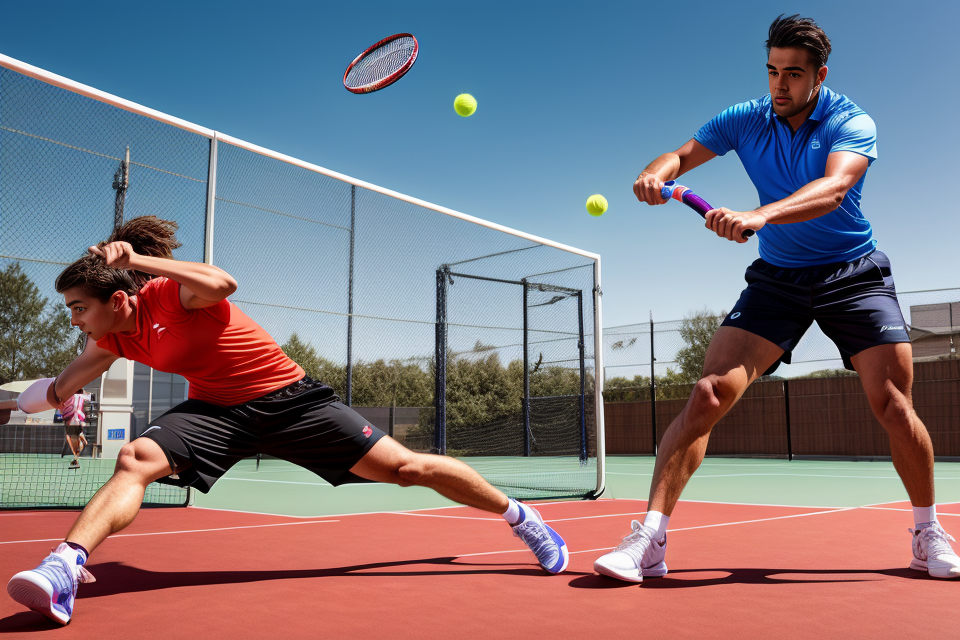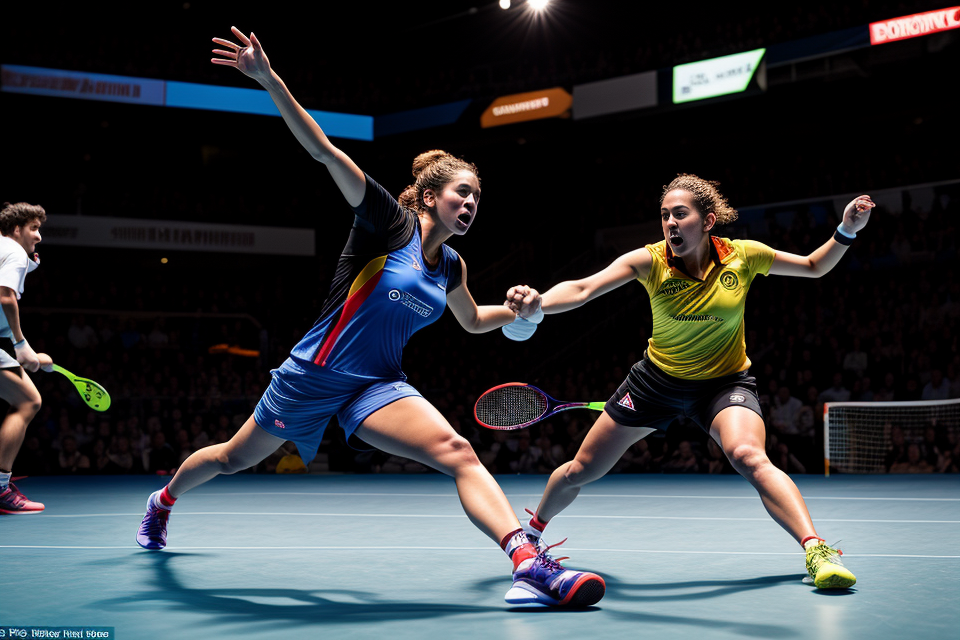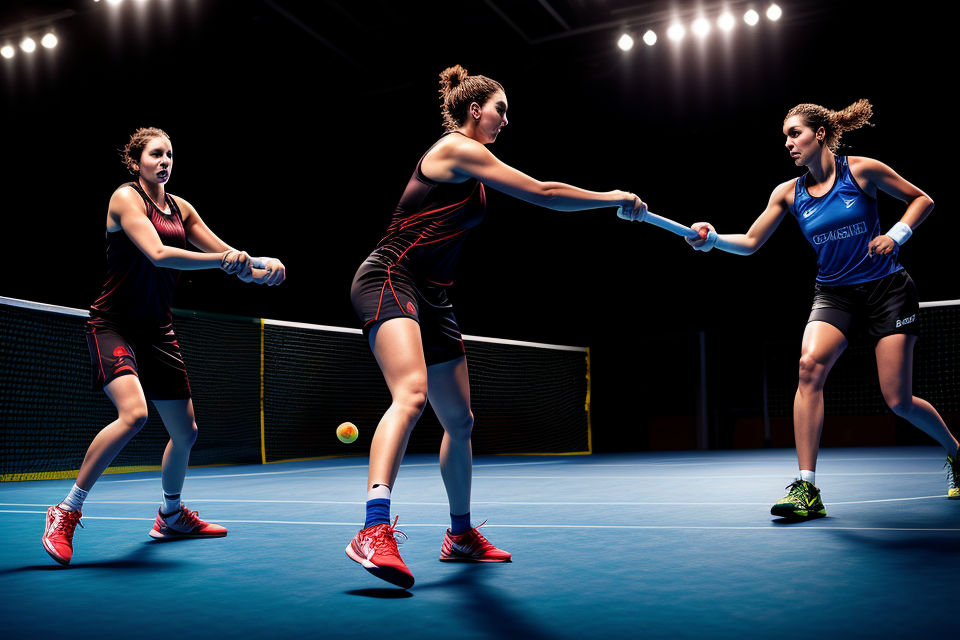Squash is a physically demanding sport that requires a combination of strength, endurance, and agility. To excel in this sport, it is essential to have a well-rounded training program that targets all aspects of your game. This comprehensive guide will provide you with the knowledge and tools necessary to maximize your squash performance. From strength and conditioning exercises to drills that focus on specific skills, we will cover everything you need to know to take your game to the next level. So, gear up and get ready to elevate your squash performance with this exciting guide!
Preparing for Squash Training
Setting Goals
Setting goals is a crucial step in preparing for squash training. It helps you to identify your strengths and weaknesses, and to establish realistic objectives that are achievable both in the short-term and long-term. Here are some steps to follow when setting goals for your squash training:
- Identifying strengths and weaknesses: The first step in setting goals is to identify your strengths and weaknesses. This can be done by analyzing your previous performances, taking feedback from your coach or teammates, and assessing your physical and mental capabilities. Once you have identified your strengths and weaknesses, you can focus on developing your strengths and improving your weaknesses.
- Establishing realistic objectives: Once you have identified your strengths and weaknesses, you can establish realistic objectives that are achievable within a specific time frame. Your objectives should be SMART – Specific, Measurable, Achievable, Relevant, and Time-bound. For example, if your strength is your forehand shot, your objective could be to improve your backhand shot by 20% in the next three months.
- Setting short-term and long-term goals: Short-term goals are objectives that you want to achieve within the next few weeks or months, while long-term goals are objectives that you want to achieve within the next year or more. It is important to set both short-term and long-term goals as it helps you to stay motivated and focused on your training. Short-term goals can be specific drills or exercises that you want to master, while long-term goals can be competitions that you want to participate in.
By following these steps, you can set goals that are achievable and realistic, and that will help you to improve your squash performance over time.
Assessing Your Fitness Level
Cardiovascular Endurance
Cardiovascular endurance is a critical aspect of squash performance as it enables you to sustain high-intensity activities for extended periods. To assess your cardiovascular endurance, you can perform a variety of tests such as a maximal aerobic power test, a sub-maximal step test, or a beep test. These tests will help you determine your current fitness level and establish a baseline for future improvements.
Muscular Strength and Endurance
Muscular strength and endurance are crucial for squash performance as they enable you to generate power and maintain your movements throughout the game. To assess your muscular strength and endurance, you can perform exercises such as squats, lunges, and push-ups. These exercises will help you determine your current strength levels and establish a baseline for future improvements.
Flexibility and Mobility
Flexibility and mobility are essential for squash performance as they enable you to move freely and execute various movements with ease. To assess your flexibility and mobility, you can perform a variety of tests such as the sit and reach test, the shoulder flexibility test, and the hip flexibility test. These tests will help you determine your current levels of flexibility and mobility and establish a baseline for future improvements.
By assessing your fitness level, you can identify your strengths and weaknesses and develop a targeted training program that will help you improve your squash performance. It is essential to remember that assessing your fitness level is just the first step in your training journey, and consistent effort and dedication are required to achieve your goals.
Developing a Squash Training Program
Warm-up and Cooldown
- Stretching exercises
- Dynamic stretching is a great way to prepare your muscles for physical activity. This type of stretching involves movements that simulate the activity you are about to perform. For example, you can perform leg swings, arm circles, and hip rotations to warm up your muscles before playing squash.
- Static stretching, on the other hand, involves holding a stretch for a period of time to improve flexibility. This type of stretching can be performed after your workout or match to help your muscles recover. Examples of static stretches include hamstring stretches, calf stretches, and tricep stretches.
- Foam rolling
- Foam rolling is a self-massage technique that can help to release tension in your muscles and improve circulation. This technique involves using a foam roller to apply pressure to tight or sore areas of your body. By doing so, you can help to break up scar tissue and increase blood flow to your muscles.
- Dynamic stretching
- Dynamic stretching is a type of stretching that involves movements that simulate the activity you are about to perform. This type of stretching is great for warming up your muscles before playing squash. Examples of dynamic stretches include leg swings, arm circles, and hip rotations.
- Static stretching
- Static stretching is a type of stretching that involves holding a stretch for a period of time to improve flexibility. This type of stretching can be performed after your workout or match to help your muscles recover. Examples of static stretches include hamstring stretches, calf stretches, and tricep stretches.
- Warm-up exercises
- Warm-up exercises are physical activities that prepare your body for physical activity. These exercises can help to increase your heart rate, elevate your core temperature, and activate your muscles. Examples of warm-up exercises include jogging, cycling, and jumping jacks.
- Cooldown exercises
- Cooldown exercises are physical activities that help to bring your heart rate and core temperature back down after physical activity. These exercises can also help to prevent soreness and improve recovery. Examples of cooldown exercises include walking, stretching, and foam rolling.
Technical and Tactical Drills
To excel in squash, it is crucial to incorporate both technical and tactical drills into your training program. Technical drills focus on developing specific skills, while tactical drills aim to improve your overall game strategy. In this section, we will discuss some essential technical and tactical drills that can help you enhance your squash performance.
Technical Drills
- Serving: The serve is a crucial aspect of squash, as it sets the tone for the game. To improve your serving technique, practice hitting the ball with different spins and speeds, aiming for the corners of the court. Additionally, focus on your footwork and ensure that you are positioning yourself correctly behind the service line.
- Volley: The volley is a shot that is hit before the opponent’s ball reaches the floor. To master the volley, practice hitting the ball with a neutral grip, keeping your non-dominant hand above your dominant hand. Also, work on your footwork, as it is essential to be in the correct position to hit the volley effectively.
- Rally: Rallies are the core of squash, and to excel in the sport, you need to be proficient in rallying. Practice hitting the ball with different strokes, such as the forehand and backhand, focusing on your technique and ensuring that you are hitting the ball with power and accuracy.
- Court movement: Squash is a fast-paced sport that requires excellent court movement skills. To improve your movement, practice jogging and sprinting around the court, as well as moving sideways and backward. Additionally, work on your footwork drills, such as shuffling and pivoting, to improve your agility and mobility on the court.
Tactical Drills
- Attacking and defending: To be a successful squash player, you need to know when to attack and when to defend. Practice hitting the ball with different spins and speeds, focusing on your shot selection and court positioning. Additionally, work on your movement, as it is essential to be in the right position to attack or defend.
- Match play drills: To prepare for actual match play, practice playing simulated matches against a wall or a practice partner. This will help you develop your match skills, such as serving, volleying, and rallying, as well as your tactical decision-making.
- Fitness training: Squash is a physically demanding sport that requires excellent fitness levels. To improve your fitness, incorporate cardiovascular exercises, such as running and cycling, into your training program. Additionally, work on your strength training, focusing on exercises that target your legs, core, and upper body.
By incorporating both technical and tactical drills into your training program, you can enhance your squash performance and improve your overall game strategy. Remember to practice regularly and focus on developing your skills, while also incorporating match play drills to prepare for actual gameplay.
Conditioning and Strength Training
In order to excel in squash, it is important to not only develop technical skills but also to enhance physical attributes that will help you perform at your best. Conditioning and strength training are essential components of a comprehensive squash training program. These exercises can help improve your endurance, speed, power, and overall fitness level, allowing you to sustain high-intensity play for extended periods of time.
Agility Drills
Agility drills are designed to improve your footwork, balance, and reaction time. They are an essential component of any squash training program, as they help you move quickly and efficiently around the court. Some examples of agility drills include ladder drills, cone drills, and shuttle runs. These drills can be modified to suit different fitness levels and can be incorporated into a full-body workout or performed as standalone exercises.
Plyometrics
Plyometrics are explosive exercises that help improve power, speed, and agility. They involve jumping, bounding, and hopping movements that help develop the fast-twitch muscle fibers needed for explosive movements on the squash court. Examples of plyometric exercises include box jumps, depth jumps, and lateral bounds. These exercises can be performed with or without equipment and can be modified to suit different fitness levels.
Strength Exercises
Strength training is important for developing the muscular endurance and power needed to perform at your best on the squash court. It can help improve your overall physical fitness, reduce the risk of injury, and enhance your athletic performance. Some examples of strength exercises that are particularly useful for squash players include squats, lunges, deadlifts, and step-ups. These exercises can be performed with or without equipment and can be modified to suit different fitness levels.
Core Stability Exercises
Core stability exercises are designed to strengthen the muscles of your core, including your abdominals, lower back, and hips. A strong core helps improve your balance, stability, and mobility, allowing you to move more efficiently and effectively on the squash court. Some examples of core stability exercises include plank variations, sit-ups, and Russian twists. These exercises can be performed with or without equipment and can be modified to suit different fitness levels.
By incorporating these conditioning and strength training exercises into your squash training program, you can improve your overall physical fitness, enhance your athletic performance, and reduce the risk of injury. Remember to consult with a qualified fitness professional before starting any new exercise program, and to progress gradually to avoid injury and ensure that you are performing exercises with proper form and technique.
Nutrition and Recovery for Squash Athletes
Fueling Your Workouts
As a squash athlete, it is crucial to pay close attention to your nutrition and recovery regimen to optimize your performance on the court. One essential aspect of this is fueling your workouts with the right nutrients. Here’s what you need to know:
Carbohydrates
Carbohydrates are the body’s primary source of energy, and they play a vital role in powering your workouts. Consuming adequate amounts of carbohydrates before and during your training sessions can help you maintain high-intensity performance and delay fatigue.
Good sources of carbohydrates include whole grains, fruits, vegetables, and starchy foods like potatoes and rice. Aim to include a mix of simple and complex carbohydrates in your diet to ensure optimal energy levels.
Protein
Protein is essential for building and repairing muscle tissue, which is crucial for athletes. Consuming adequate amounts of protein can help you recover faster from training sessions and maintain muscle mass.
Good sources of protein include lean meats, fish, eggs, dairy products, legumes, and nuts. Aim to include a source of protein with each meal to support your muscle recovery and growth.
Hydration
Staying hydrated is critical for athletes, as it helps regulate body temperature, maintain blood volume, and support muscle function. Drinking enough water before, during, and after your workouts can help prevent dehydration and improve your overall performance.
Aim to drink at least 8-10 glasses of water per day, and more if you’re training for longer periods or in hot weather conditions. You can also consider incorporating electrolyte-rich beverages like sports drinks or coconut water to help replace lost minerals during intense training sessions.
In summary, fueling your workouts with the right nutrients is essential for maximizing your squash performance. Make sure to include a mix of carbohydrates, protein, and hydration in your diet to support your training and recovery efforts.
Post-Workout Recovery
Post-workout recovery is a crucial aspect of any training program, as it allows the body to repair and rebuild muscle tissue, reduce muscle soreness, and improve overall performance. For squash athletes, effective post-workout recovery strategies can help prevent injury, enhance muscle growth and repair, and promote optimal physical and mental health. Here are some key elements of effective post-workout recovery for squash athletes:
Rest and Sleep
Rest and sleep are essential components of post-workout recovery. During sleep, the body releases hormones that promote muscle growth and repair, such as growth hormone and testosterone. Adequate sleep also helps to reduce muscle soreness and fatigue, allowing athletes to perform at their best during training sessions. Squash athletes should aim for at least 7-9 hours of sleep per night, and should prioritize rest and recovery days to allow for sufficient rest between training sessions.
Nutrient Timing
Nutrient timing refers to the strategic timing of nutrient intake to optimize muscle recovery and growth. For squash athletes, post-workout nutrient timing can help to replenish energy stores, promote muscle recovery, and support overall performance. Some key nutrients for post-workout recovery include:
- Carbohydrates: Carbohydrates are the primary source of energy for muscles during exercise. Consuming carbohydrates after a workout can help to replenish energy stores and support muscle recovery. Good sources of post-workout carbohydrates include fruits, vegetables, whole grains, and sports drinks.
- Protein: Protein is essential for muscle growth and repair. Consuming protein after a workout can help to stimulate muscle protein synthesis, which is the process by which muscles repair and grow. Good sources of post-workout protein include lean meats, fish, eggs, dairy products, and plant-based protein sources such as beans and legumes.
- Vitamins and minerals: Vitamins and minerals are important for overall health and performance. Consuming a balanced diet that includes a variety of fruits, vegetables, whole grains, and lean protein sources can help to ensure adequate intake of these nutrients.
Active Recovery Techniques
Active recovery techniques involve low-intensity exercise or movement that helps to promote recovery without exacerbating muscle soreness or fatigue. Some examples of active recovery techniques for squash athletes include:
- Light jogging or walking: Light aerobic exercise can help to improve circulation, reduce muscle soreness, and promote recovery.
- Yoga or stretching: Yoga and stretching can help to improve flexibility, reduce muscle tension, and promote relaxation.
- Foam rolling or massage: Foam rolling and massage can help to release tension in tight muscles and improve circulation.
Overall, effective post-workout recovery strategies can help squash athletes to optimize their training, prevent injury, and perform at their best on the court. By prioritizing rest, nutrient timing, and active recovery techniques, squash athletes can support their overall health and performance and achieve their goals on the squash court.
Mental Game and Squash Performance
Visualization Techniques
Visualization is a powerful tool that can help you improve your squash performance by allowing you to mentally rehearse your actions and develop a sense of confidence and control. By visualizing yourself successfully executing different aspects of the game, you can reduce anxiety, increase motivation, and enhance your overall mental toughness.
Goal Setting
One of the most effective ways to use visualization in squash is to set specific goals for yourself. Start by identifying the areas of your game that you want to improve, such as your footwork, shot selection, or fitness level. Then, create a mental image of yourself successfully achieving these goals. Imagine yourself executing each aspect of the game with precision and confidence, and feel the satisfaction of reaching your desired outcome.
Anxiety Management
Visualization can also be a valuable tool for managing anxiety and stress during competition. If you find yourself feeling overwhelmed or nervous before a match, take a few moments to mentally rehearse your performance. Imagine yourself handling different scenarios and coping with any challenges that may arise. This can help you feel more confident and in control, and reduce your overall anxiety levels.
Confidence Building
Finally, visualization can be a powerful way to build confidence in your abilities. By mentally rehearsing your successes and visualizing yourself achieving your goals, you can develop a stronger sense of self-belief and trust in your skills. This can help you approach each match with a positive mindset and a greater sense of determination.
In summary, visualization techniques can be a valuable addition to your squash training regimen. By setting specific goals, managing anxiety, and building confidence, you can use visualization to enhance your mental game and improve your overall squash performance.
Match Strategies
In order to perform at your best on the squash court, it’s important to have a solid strategy for your matches. This section will cover some key aspects of match strategies that can help you improve your performance.
Court positioning
The positioning of players on the court can have a significant impact on the outcome of a match. A key aspect of court positioning is to control the “T” area of the court, which is the central area of the court where the walls meet at a 90-degree angle. By controlling this area, you can force your opponent off the wall and into the back corners of the court, where they will have to hit shots that are more difficult to control.
To effectively control the “T” area, it’s important to be able to move quickly and efficiently around the court. This means practicing your footwork and agility drills to ensure that you can get into position to hit your shots.
Shot selection
The shots you choose to hit can also have a big impact on your match strategy. It’s important to have a range of shots in your arsenal, including cross-court shots, lobs, and boasts. However, it’s also important to choose the right shot for the situation. For example, if you’re ahead in the game, you may want to play more defensively and hit safe shots to keep the ball in play. On the other hand, if you’re behind in the game, you may need to take more risks and hit more aggressive shots to try and turn the match around.
In addition to choosing the right shots, it’s also important to be able to execute them accurately. This means practicing your shot selection and accuracy in training to ensure that you can hit the shots you want to hit in a match.
Match analysis
Analyzing your matches can be a valuable tool for improving your performance. This involves reviewing your matches and identifying areas where you can improve. For example, you may want to look at your shot selection and see if there are certain shots that you struggle with or if there are shots that you could be hitting more often. You may also want to look at your court positioning and see if there are areas where you could be more effective.
By analyzing your matches, you can identify patterns in your play and work on fixing any weaknesses. This can help you develop a more effective match strategy and improve your overall performance on the court.
Injury Prevention and Safety in Squash
Ergonomics and Technique
Proper Footwork
Proper footwork is crucial in preventing injuries and improving performance in squash. Players should be aware of their body mechanics and the positioning of their feet during each movement. It is important to have a balanced stance and maintain a low center of gravity to provide stability and power. To develop proper footwork, players should practice the following drills:
- Forward and backward lunges
- Lateral lunges
- Quick changes of direction
- Multi-directional movements
Correct Grip and Swing
A correct grip and swing are essential for generating power and control in squash. The grip should be firm but relaxed, with the dominant hand on top and the non-dominant hand on the bottom. The swing should be smooth and controlled, with the racquet head moving in a straight line. To develop a correct grip and swing, players should practice the following drills:
- Warm-up swings
- Ball toss drills
- Target practice
- Volley drills
Avoiding Common Injuries
In addition to proper footwork and technique, players should be aware of common injuries in squash and take steps to prevent them. The most common injuries include:
- Elbow pain and tendonitis
- Wrist injuries
- Ankle sprains
- Back pain
To avoid these injuries, players should incorporate the following preventative measures into their training:
- Warm-up and cool-down exercises
- Stretching and flexibility training
- Strength and conditioning exercises
- Proper equipment and footwear
By following these guidelines, players can minimize their risk of injury and improve their performance on the squash court.
Equipment and Facility Safety
Court Surface Maintenance
Maintaining a well-conditioned court surface is essential for ensuring safety while playing squash. The court should be clean and free from debris, with a non-slip surface to prevent slips and falls. The surface should also be checked regularly for any damage or wear and tear, and repairs should be made promptly to avoid accidents.
Eye Protection
Eye protection is a crucial aspect of safety in squash. A polycarbonate eye shield should be worn at all times during play to protect the eyes from fast-moving squash balls. The eye shield should fit securely and comfortably, and the player should be able to see clearly through it.
Proper Footwear
Proper footwear is essential for preventing injuries in squash. A good squash shoe should have a non-marking sole, good grip on the court surface, and good support for the foot. The shoe should also be comfortable and fit well to prevent blisters or other foot injuries. Additionally, the shoe should be clean and free from debris to prevent slips and falls on the court.
Long-term Athlete Development in Squash
Periodization and Progression
- Planning training cycles
- Gradual increases in intensity and volume
- Incorporating variety and change
Planning training cycles
- Identifying short-term and long-term goals
- Periodizing training into phases
- Allocating time for different aspects of training
Gradual increases in intensity and volume
- Starting with a baseline and gradually increasing intensity and volume
- Incremental progression to avoid injury and overtraining
- Regular monitoring of physical and mental state
Incorporating variety and change
- Introducing new drills and exercises to prevent boredom and stagnation
- Changing training environments to keep it interesting
- Varying the pace and intensity of training sessions
Continuous Improvement and Feedback
Seeking Coaching and Guidance
Professional coaching can provide valuable insight and guidance to help you continuously improve your squash performance. A coach can analyze your technique, identify areas for improvement, and design a training program tailored to your specific needs and goals.
Video Analysis
Video analysis is a powerful tool for identifying and correcting technical errors in your squash game. By recording your matches or practice sessions, you can review your performance and identify areas where you need to improve. You can also compare your performance to that of top professionals to learn from their techniques and strategies.
Peer Feedback and Learning from Others
Learning from your peers can also be a valuable source of feedback and improvement. Playing matches and participating in training sessions with other squash players can help you develop your skills and strategies, as well as provide you with feedback on your performance. You can also learn from others’ strengths and weaknesses, and apply those lessons to your own game.
Additionally, observing and learning from professional squash players can provide inspiration and motivation to improve your own performance. By studying the techniques and strategies of top players, you can gain insights into how to improve your own game and achieve success on the court.
FAQs
1. What are the key components of a successful squash training program?
A successful squash training program should include a combination of physical conditioning, technical skill development, and match-specific drills. This will help to improve your overall fitness, enhance your shot-making ability, and prepare you for competition.
2. How many times a week should I train to see improvement in my squash performance?
Training twice a week is typically sufficient for most players to see improvement in their squash performance. However, more advanced players may benefit from training three or more times per week. It’s important to allow for adequate recovery time between sessions to avoid injury and prevent burnout.
3. What types of physical exercises should I include in my squash training program?
In addition to on-court drills, it’s important to incorporate off-court exercises that target the muscles used in squash, such as cardio work, strength training, and flexibility exercises. Cardio work will help improve your endurance and cardiovascular health, while strength training will help build the muscles used in squash, such as your legs, core, and upper body. Flexibility exercises will help prevent injury and improve your range of motion.
4. How can I improve my squash skills?
To improve your squash skills, it’s important to practice the basic techniques of the game, such as serving, volleying, and hitting. You can also work on your footwork and agility to improve your movement on the court. It’s also important to play matches and compete against other players to apply what you’ve learned in a match-like setting.
5. What are some effective drills to improve my squash performance?
Some effective drills to improve your squash performance include ball control drills, such as hitting against a wall or using a rebounder, and technical drills, such as working on your footwork and stroke mechanics. You can also practice match-specific drills, such as simulated match play, to prepare for competition.
6. How can I prevent injury while training for squash?
To prevent injury while training for squash, it’s important to warm up properly before each session and cool down afterwards. You should also allow for adequate recovery time between sessions and avoid overtraining. Additionally, it’s important to use proper technique and form when executing movements on the court to avoid putting excess strain on your muscles and joints.






